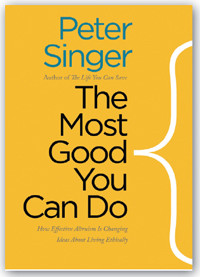
The Most Good You Can Do: How Effective Altruism is Changing Ideas About Living Ethically
Peter Singer
211 pages, Yale University Press, 2015
In “Famine, Affluence, and Morality,” an enormously influential article published in 1972, the philosopher Peter Singer posed the following hypothetical: You are walking by a shallow pond and see a young child drowning. You could wade into the pond and save her, but doing so would ruin a $500 pair of shoes. Are you morally required to save the child? If, like most people, you answer yes, then Singer has another question for you: Why are you not under an equal or greater moral duty to contribute $500 to fight global starvation—an act of generosity that could save 10 lives or more? If the point of helping others is to help them, and not to make ourselves feel good, shouldn’t we give where our money will produce the most good? There are powerful psychological reasons why we are more inclined to save the child in front of us than we are to save a nameless, faceless child 8,000 miles away, but are there moral reasons?
In recent years, Singer has taken his case—and his discomforting questions—directly to the public. Those efforts have helped inspire the Effective Altruism (EA) movement, a worldwide network of people who have made a commitment to fight global poverty and disease. Many members of EA have pledged to give a significant percentage of their future income to that cause. The Most Good You Can Do is Singer’s latest outreach effort on behalf of EA. It’s partly an evangelizing effort and partly a how-to guide for the converted. To my mind, the book is less than wholly successful on both fronts, for reasons that highlight the challenges that EA faces as it seeks to become a mainstream movement.
EA is not an easy product to sell. Its core belief—that if we can save someone else from death at a trivial cost to ourselves, we are morally obligated to do so—is widely if not universally shared. But EA asks us to extend the logic of that belief to places where most of us don’t want to go. It urges a level of charitable giving that is many times greater than what most people currently give. It asks us to be guided not by emotion but by reason in choosing how and where to give. And hardest of all, it asks us to care as much about the lives of distant, unidentified others as we do about a drowning child whom we happen upon.
For Singer and other EA members, many of whom are committed utilitarians, the moral demands of EA are compelled by, and limited only by, the logic of utilitarianism: We should help others until further help will do more harm than good overall. In the past, Singer urged people to give away up to 10 percent of their annual income. (He urged people who are mega-rich to give more.) In The Most Good You Can Do, he pulls fewer punches on this score. The book off ers as exemplars several people who have lived in accordance with the stringent morality of EA. Singer calls them “ordinary,” but most of them have made what readers are likely to regard as extraordinary sacrifices. One of Singer’s “ordinary” altruists gave away most of a multi-million-dollar fortune, retaining only enough to yield a $60,000 annual income for him and his family; he even donated one of his kidneys to a stranger. Singer clearly hopes that such examples will inspire others to follow suit, but I suspect that they will have the opposite effect on most people.
Singer’s metric of goodness also derives from utilitarianism: We should act so as to increase the aggregate welfare of society. In practice, that standard gives priority to saving lives, and it measures success by the number of lives saved. In The Most Good You Can Do, Singer pulls no punches about the implications of this principle, either. He argues that it’s morally indefensible to give money to build a new wing at the Metropolitan Museum of Art, or to supply guide dogs to the blind, when it could go toward anti-poverty efforts that would save hundreds if not millions of lives. But that isn’t a battle that EA can win, and it isn’t a battle that EA needs to win if its goal is to increase aid to the global poor. Waging that battle also comes at a high cost. It sidetracks people into arguments over utilitarianism as a moral theory and leads them to ignore the substantial common ground between utilitarianism and common-sense morality—common ground that Singer’s “shallow pond” example brilliantly highlighted. And by insisting that reason is morally superior to emotional empathy, EA can be read to insist that effective altruists are morally superior to every one else. Singer, in this book, doesn’t shy away from that implication—not a strategy likely to win friends and influence people.
These problems are practical, rather than moral, in nature. But for a movement dedicated to effective altruism, they are important. The core message of EA is as powerful now as it was when Singer first pressed it 40 years ago. The central challenge for EA, as it works to go mainstream, is to translate that message into a call to action with broad appeal.

